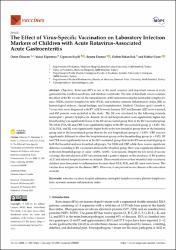Evaluation of the relationship between monocyte to high-density lipoprotein cholesterol ratio and thrombus burden in patients with deep vein thrombosis
Künye
Doğan, Z., Bektaşoğlu, G., Dümür, Ş., Uzun, H., Erden, İ., & Yurtdaş, M. (2023). Evaluation of the relationship between monocyte to high-density lipoprotein cholesterol ratio and thrombus burden in patients with deep vein thrombosis. Revista da Associacao Medica Brasileira (1992), 69(4), e20221211. https://doi.org/10.1590/1806-9282.20221211Özet
Bu çalışmanın amacı, derin ven trombozlu hastalarda monosit sayısı ve yüksek yoğunluklu lipoprotein kolesterol düzeylerini ve oranlarını (monosit/yüksek yoğunluklu lipoprotein oranı) değerlendirmek ve tanı anında bu oranın uygulanıp uygulanamayacağını belirlemektir. derin ven trombozunda trombüs yerleşimi açısından trombüs yükünün bir göstergesidir.
2018 ve 2022 yılları arasında ayakta tedavi gören hastalar için bir veri tabanı sorgusu kullanarak, hastanın venöz Doppler ultrason ile doğrulanan derin ven trombozu tanısını retrospektif olarak analiz ettik. Dahil edilen 378 hastadan 356'sının tanı anında kan sayımı sonuçları mevcuttu. ve kontrol grubu olarak, poliklinik veri tabanı sorgulanarak, kan sayımı uygun olan, derin ven trombozu tanısı olmayan cinsiyet uyumlu hastalar alındı. Monosit/yüksek yoğunluklu lipoprotein oranı, monosit sayısının yüksek yoğunluklu lipoprotein-C'ye oranından hesaplanmıştır. Hastalar, Doppler ultrason bulguları ile kanıtlandığı gibi, trombüs düzeyine ve tutulan damar segmentlerinin sayısına göre kategorize edildi.
Serum monosit/yüksek dansiteli lipoprotein oranı hasta grubunda kontrol grubuna göre anlamlı olarak yüksekti (p<0.01). Proksimal derin ven trombozu olan hastalarda ortalama monosit/yüksek yoğunluklu lipoprotein oranı (19.6±5.1'e karşı 17.1±5.5; p<0.01), distal derin ven trombozu olan hastalardan daha yüksekti. Monosit/yüksek yoğunluklu lipoprotein oranı tutulan damar segmenti sayısı ile arttı (p<0.01).
Monosit/yüksek dansiteli lipoprotein oranı derin ven trombozlu hastalarda kontrol grubu ile karşılaştırıldığında anlamlı olarak yüksektir. Monosit/yüksek yoğunluklu lipoprotein oranı seviyeleri, trombüsün konumu ve derin venöz tromboz hastalarında yer alan ven segmentlerinin sayısı tarafından yansıtılan hastalık yükü ile korele idi. The aim of this study is to evaluate the monocyte count and high-density lipoprotein cholesterol levels and ratios (monocyte/high-density lipoprotein ratio) in patients with deep vein thrombosis and to determine whether this ratio can be applied at the time of diagnosis. In deep vein thrombosis, it is an indicator of thrombus load in terms of thrombus location.
Using a database query for outpatients between 2018 and 2022, we retrospectively analyzed the patient's diagnosis of deep vein thrombosis, which was confirmed by venous Doppler ultrasound. Of the 378 patients included, 356 had blood count results at the time of diagnosis. and as the control group, gender-matched patients without deep vein thrombosis diagnosis and with appropriate blood count were included by querying the outpatient clinic database. The monocyte/high-density lipoprotein ratio was calculated from the ratio of monocyte count to high-density lipoprotein-C. Patients were categorized according to the level of thrombus and the number of involved vessel segments, as evidenced by Doppler ultrasound findings.
Serum monocytes/high-density lipoprotein ratio was significantly higher in the patient group than in the control group (p<0.01). The mean monocyte/high-density lipoprotein ratio (19.6±5.1 vs. 17.1±5.5; p<0.01) was higher in patients with proximal deep vein thrombosis than in patients with distal deep vein thrombosis. Monocyte/high-density lipoprotein ratio increased with the number of involved vessel segments (p<0.01).
Monocyte/high-density lipoprotein ratio was significantly higher in patients with deep vein thrombosis compared to the control group. Monocyte/high-density lipoprotein ratio levels were correlated with disease burden as reflected by the location of the thrombus and the number of vein segments involved in deep venous thrombosis patients.

















